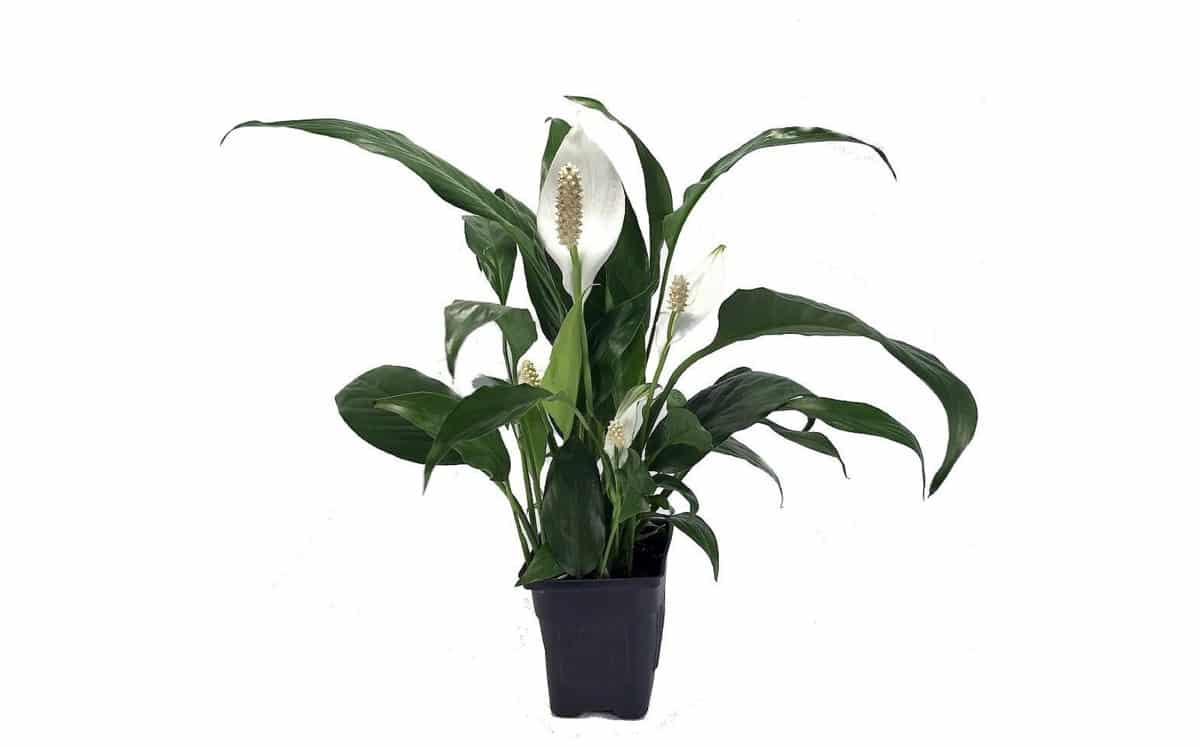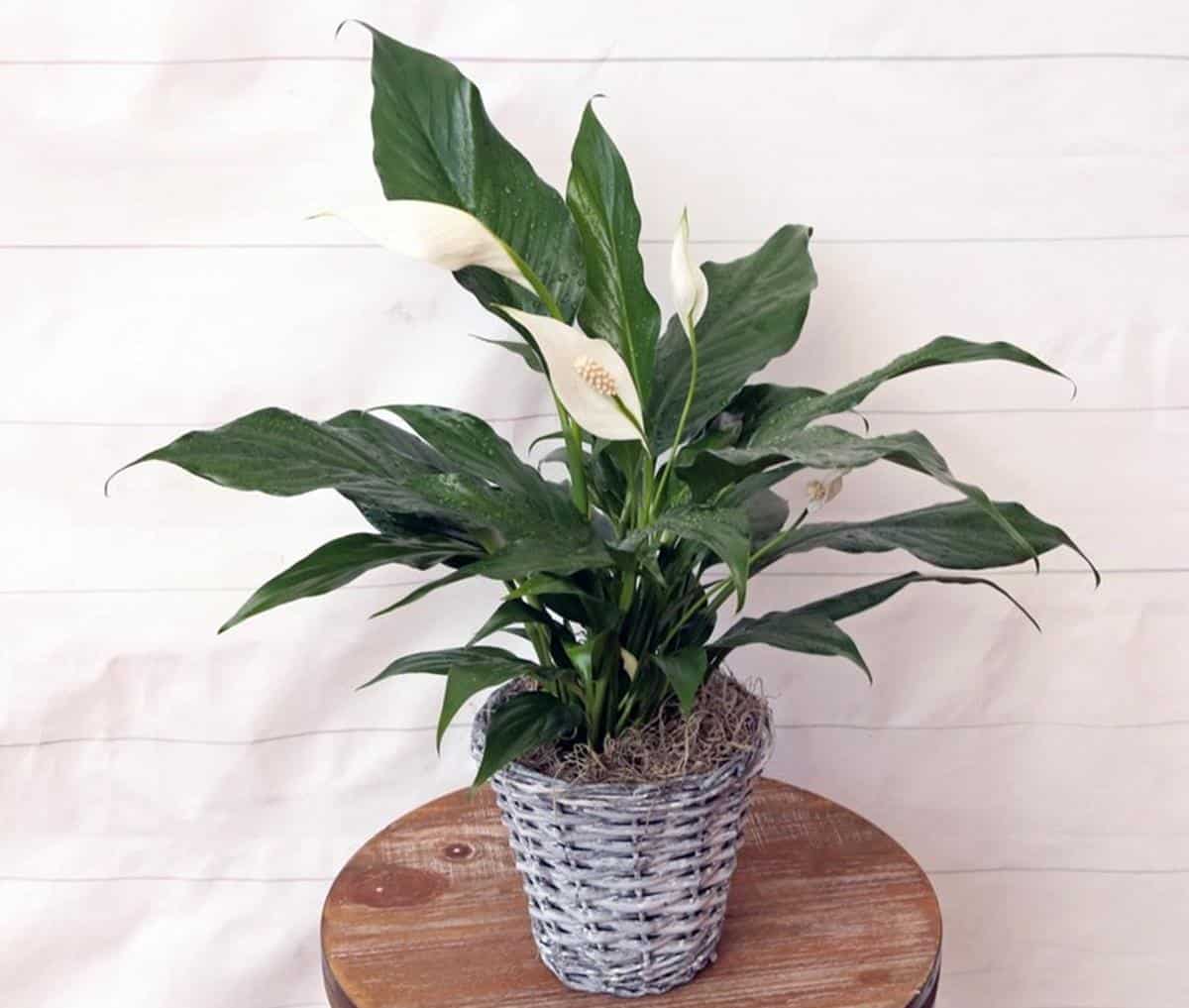An overwatered peace lily (Spathiphyllum) will have yellow lower leaves and drooping or wilt, yet the soil is moist, and the leaves feel soft (not dry or crispy). Also, you may notice brown or black splotches, a moldy potting mix, a mushy stem base, etc. If ignored, your plant will end up with root rot that will ultimately kill your plant.
We will tell you what an overwatered peace lily looks like or signs and give you the causes and what to do or how to save your overwatered plant.
Since they are closely related, we will also look at underwatered peace lily and how to revive your thirsty plant. By the end of the post, you will have learned how to water your plant and a lot more.

Contents
- Why do you overwater your peace lily
- Why overwatering is bad
- What does an overwatered peace lily look like or signs
- How to save an overwatered peace lily or care
- 1. When no root rot
- 2. When your plant has root rot
- 3. Things never to do
- Underwatered peace lily
- 1. Signs
- 2. Causes
- 3. How to revive your peace lily
- 4. Tips to prevent future cases
Why do you overwater your peace lily
How much water this plant needs depends on the season, light, temperature, humidity, and soil mix. Also, your plant size, pot size, or type will affect water needs.
Usually, people overwater their Spathiphyllum for the following reasons.
- You water your plant too often without first feeling the soil.
- Following a watering schedule or program
- Heavy and poorly draining potting soils, including compacted potting mixes
- Pots with blocked or without drainage holes
- Oversized pots
- Poor air circulation, especially when the humidity is very high
- Not emptying water on your cache pot or saucer
Why overwatering is bad
The peace lily plant grows best in consistently moist soil, and you can even grow them in water. But they don’t like soggy soil or even dry ones.
When the soil is soggy, it cuts off oxygen from roots. But this plant needs oxygen for aerobic respiration, a process by which they break down food into carbon dioxide, energy, and water. So, they will lack energy and weaken.
The other thing is water and nutrient absorption, i.e., when roots don’t get oxygen, their permeability decreases, making it hard for them to absorb water and minerals.
That is not all. The constantly wet potting mix also favors the growth of soilborne pathogens like Cylindrocladium spathyphylli and Phytophthora parasitica to attack the already weakened roots, causing root rot. Others fungi responsible for decay include Rhizoctonia solani, Pythium ssp., and Sclerotium rolfsii (Southern blight).
If not detected or treated early, peace lily root rot may kill your plant. So, a minor issue such as overwatering may end up destroying your plant.
What does an overwatered peace lily look like or signs
Here are the signs or how to know if your peace lily is overwatered :
- A wet or soggy potting mix even after not watering for a couple of days.
- Leaves will turn yellow, starting with the lower ones.
- Your peace lily will droop or wilt but will not improve even after watering. Also, the leaves will not feed dry or crispy like in the case of an underwatered Spathiphyllum.
- Wart-like white, brown, or tan blisters due to leaf edema
- Leaves start turning brown or having black or brown splotches.
- Leaves curling
- Potting mix attracting moisture-loving pests like fungus gnats
- Brown spots with some having a yellow halo in case of Spathiphyllum root rot. But in the case of Phytophthora root rot, there will be no yellow halo.
- Moldy potting mix that may have a foul smell
- Mushy stem base
- Slow or stunted growth
- Leaves and flowers dropping
Some signs such as your peace lily yellow leaves, falling off, curling, wilting, and drooping may have other causes too. Thus, it would be best to look at whether the soil mix is wet or moist and root rot.
Last but not least, some of what we have given you are also signs of root rot in this plant.
How to save an overwatered peace lily or care
To successfully save an overwatered peace lily, investigate the reasons for overwatering. Is it the growing conditions, oversized pot, or you water too often? We’ve already given you the leading causes. Next, slide your plant out to check if it has root rot.
1. When no root rot
When there is no root rot, overwatered peace lily care will include the following:
- Holding the watering until the top one inch of the soil feels dry.
- Improving soil aeration and drying, poking your pot mix with a chopstick or pencil.
- If you have a compacted, heavy, or poorly draining potting mix, change it. An equal blend of perlite, potting soil, and peat moss or coconut coir will work well. You can also buy an aroid mix from Etsy.com.
- For people in Is your plant in a dark place or areas with low temperature? Move it to a place with bright, indirect light and maintain optimum temperature.
- The other thing is to increase air circulation, especially if your humidity is very high. It will make the soil dry faster.
- Lastly, if you have an oversized pot, get a smaller one.
- Remove any damaged or diseased leaves
2. When your plant has root rot
If, unfortunately, your plant has root rot, you need to assess the damage. If all the roots look black or brown and mushy, it’s too late. Just discard the plant. But if you see some white or tan roots with white tips, you can save your plant.
Here is what you need to do:
- Get a new pot or disinfect the current one with a 10% bleach solution.
- Slide the plant outside, tap it lightly to get rid of excess, then wash it under running water.
- Use a sterilized pruning scissor to cut any mushy, brown, or black roots just above where the damage is.
- Sterilize your pruning scissor again with 70-100% isopropyl alcohol and cut between ⅓ to ½ of the leaves. How much you cut depends on the amounts of roots you removed. Otherwise, your plant will struggle to feed these leaves with a small root.
- Dip the root in a fungicide to prevent reinfection and plant it in your new pot. Never use the old potting mix.
3. Things never to do
- Never squeeze your potting mix to get rid of excess water. It will damage the roots.
- Don’t feed your peace, lily. Fertilizers will favor Pythium root rot
Underwatered peace lily
Yes, peace lilies are more sensitive to overwatering than underwatering. Nonetheless, prolonged droughts will harm or even kill your plant.
1. Signs
- Dried soil pulled from the pot sides
- Thinner, less plump leaves
- Wilting and drooping that improves when watering
- Your peace lily leaves will curl inward to help reduce further water loss
- Leaves turning yellow
- Leaf scorch or leaf with crispy dry tips, margins, or patches. Also, you may notice your peace lily flower browning, especially brown tips.
- Slow or stunted growth
- Leaves and flowers falling
If you don’t water your plant in time, it may wither and die. But this will take a while, not a few days.
2. Causes
The most common reason for underwatering is neglect or forgetting to water your plants. Other possible causes include:
- Potting mixes that dry too quickly
- A tiny pot
- Your plant is root bound
- Low humidity
- Too much light
- High temperatures
- Shallow, frequent watering
- Following a watering schedule yet water needs will change.
3. How to revive your peace lily
Confirm if your plant is thirsty. You can use XLUX Soil Moisture Meter or your finger (dry up to the first knuckle). Water when the reading is three or less.
Next, plant a good drink. If you go for top watering, slowly and evenly saturate until excess water flows from the drainage hole. Please wait for a short while and do it again to ensure the soil is moist. Then drain whatever collects on the pot saucer.
For those who love bottom watering, place your pot in a basin with water 3-4 inches deep for 45 minutes. Then feel if the top 2-3 inches of the soil is wet. If not, lightly water the plant from the top. Afterward, let the excess water drain for about 15 minutes and return your pot to its place.
If there are any damaged leaves, you need to cut them off with a sterilized pruning scissor. But if it’s just tips or edges, trim them, i.e., don’t remove the whole leaf.
Next, investigate if you have the right potting mix and pot size. If not, amend as necessary. And you also need to ensure you maintain optimum growing conditions, i.e., temperature, humidity, lighting, and so on.
4. Tips to prevent future cases
To prevent future incidences, here is what you need to do:
- Water your plant when the top one inch feels dry. This may be after about a few days to a week. But the exact time depends on your environmental conditions and other factors.
- Never follow a peace lily watering schedule you get online. Instead, always feel the soil to know if it is time to give your plant a drink or you need to wait a little longer.
- Get an average time it takes to water your plant and set a reminder alert. When you receive the alert, feel the soil before watering your plant.
- Consider a self-watering pot. HBServices USA has a perfect 6” Self-Watering pot you will like. Your work will be filling the reservoir.





Jenny
Hi!
My peace lily was overwatered and had some root rot, but those roots were already gone and had dried up when I checked, and the affected clusters of leaves were loose since they weren't sticking to the soil anymore, I simply removed them. there is no funny smell at all from the soil I even poked a stick through the soil and smelled it.. the question is should I repot the plant still?
Editorial Team
Yes. We highly recommend repotting your peace lily since the pathogens responsible for the decay may still be lingering in the potting mix. Alternatively, you can try pouring a hydrogen peroxide mixture around the root area. To use it, add a teaspoon (15ml) of 3% hydrogen peroxide to a cup of water (240ml). See more on Peace lily root rot.